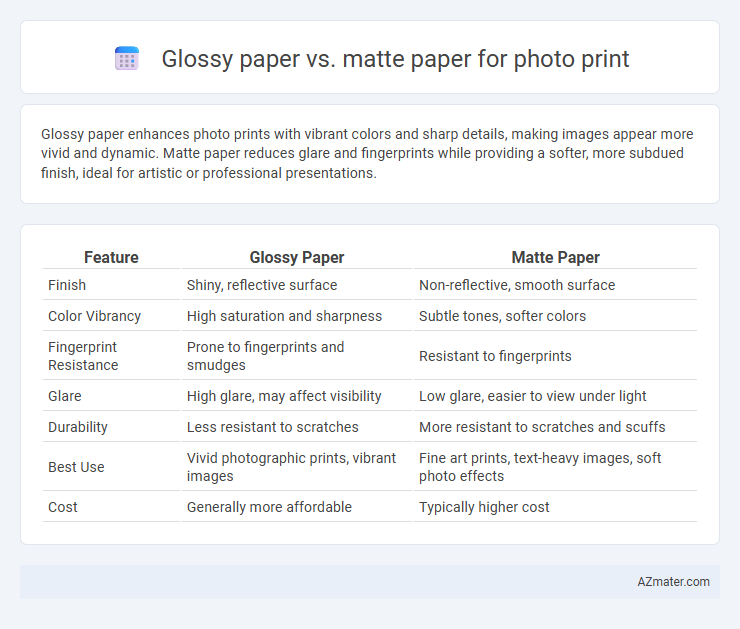Glossy paper enhances photo prints with vibrant colors and sharp details, making images appear more vivid and dynamic. Matte paper reduces glare and fingerprints while providing a softer, more subdued finish, ideal for artistic or professional presentations.
Table of Comparison
| Feature | Glossy Paper | Matte Paper |
|---|---|---|
| Finish | Shiny, reflective surface | Non-reflective, smooth surface |
| Color Vibrancy | High saturation and sharpness | Subtle tones, softer colors |
| Fingerprint Resistance | Prone to fingerprints and smudges | Resistant to fingerprints |
| Glare | High glare, may affect visibility | Low glare, easier to view under light |
| Durability | Less resistant to scratches | More resistant to scratches and scuffs |
| Best Use | Vivid photographic prints, vibrant images | Fine art prints, text-heavy images, soft photo effects |
| Cost | Generally more affordable | Typically higher cost |
Introduction to Photo Print Paper Types
Glossy paper offers a shiny finish that enhances color vibrancy and detail sharpness, making it ideal for photo prints requiring high contrast and clarity. Matte paper provides a non-reflective surface, reducing glare and fingerprints, which suits artwork reproductions and photos with softer tones. Understanding these distinct finishes helps photographers and artists select the best paper type for their desired visual effect and presentation.
What is Glossy Paper?
Glossy paper is a photo printing medium characterized by its shiny, reflective finish that enhances color vibrancy and sharpness, making images appear more vivid and detailed. It is coated with a smooth, lustrous layer that resists moisture and fingerprints, ideal for high-contrast and colorful photographs. Commonly used in professional photo prints, glossy paper brings out the depth and intensity of hues, but can produce glare under bright lighting conditions.
What is Matte Paper?
Matte paper is a non-glossy, textured photo paper designed to reduce glare and reflections, providing a smooth, fingerprint-resistant finish ideal for fine art prints and professional photography. It typically offers deeper color saturation and better readability for text, making it suitable for detailed images that require subtle tonality without the shine of glossy surfaces. Matte paper's durability and smudge resistance make it a preferred choice for photos displayed under bright lighting or handled frequently.
Glossy Paper: Key Features and Benefits
Glossy paper offers high contrast and vibrant color reproduction, making photo prints appear sharp and lifelike. Its smooth, reflective surface enhances detail clarity and provides a professional, polished finish that resists fading and fingerprints. Ideal for showcasing vivid images and fine details, glossy paper is preferred for photo prints intended for display and presentation.
Matte Paper: Key Features and Benefits
Matte paper offers a non-reflective surface that reduces glare, making photo prints easier to view under various lighting conditions and ideal for art displays or professional presentations. It provides a smooth, textured finish that enhances color saturation and fine detail without the shiny, reflective finish that glossy paper has, resulting in a more understated and sophisticated look. Matte paper also resists fingerprints and smudges more effectively, ensuring the longevity and durability of photo prints.
Image Quality: Glossy vs Matte
Glossy paper enhances photo print quality with vibrant colors and sharp details due to its reflective coating that intensifies contrast and depth. Matte paper offers a softer, non-reflective finish that reduces glare and fingerprints, producing more muted tones and subtle texture ideal for an artistic or vintage look. Choosing between glossy and matte impacts image sharpness, color saturation, and viewing experience based on lighting conditions and intended presentation.
Durability and Longevity Comparison
Glossy paper offers a vibrant finish with a protective coating that enhances durability against scratches and moisture, making it suitable for photos exposed to frequent handling. Matte paper resists fingerprints and glare better, providing longer-lasting image clarity especially in environments with direct light, but it may be more susceptible to surface wear over time. Both types use acid-free materials to ensure archival quality, with specific coatings playing a critical role in the print's longevity and resistance to fading.
Best Use Cases for Glossy Paper
Glossy paper excels in photo printing when vibrant color reproduction and sharp detail are priorities, making it ideal for portraits, landscapes, and images with high contrast or saturated hues. It enhances depth and brightness, perfect for professional photography displays, promotional materials, and photo albums where visual impact is crucial. Glossy finishes also provide a polished look that attracts attention in retail prints and marketing collateral.
Best Use Cases for Matte Paper
Matte paper is ideal for photo prints requiring a smooth, non-reflective finish that reduces glare and fingerprints, making it perfect for gallery displays and professional portfolios. Its textured surface enhances detail and color depth in black-and-white images, portraits, and art prints, providing a sophisticated and soft aesthetic. Matte paper also performs well in brightly lit environments, ensuring visibility without distracting reflections.
Choosing the Right Paper for Your Photos
Glossy paper enhances photo prints with vibrant colors and sharp contrasts, making it ideal for images requiring a striking, polished finish. Matte paper offers a non-reflective surface that reduces glare and fingerprints, perfect for photos with subtle tones or a classic, understated look. Choosing the right paper depends on your desired visual impact, lighting conditions, and how you plan to display the photo.

Infographic: Glossy paper vs Matte paper for Photo print
 azmater.com
azmater.com